The following morning we were already on our way to a next tour, this time to the Ba Be National Park and the Ban Gioc waterfalls. When I planned this trip, I realized that most of the agencies offered a two-day version and a lot of adventures, but only in the national park around the Ba Be lake. However, I really wanted us to go to the biggest waterfalls in Vietnam that do not belong to the national park and that are quite far away, on the very border with China, but they were in the same general direction – north-east from Hanoi. Eventually, I did manage to arrange a three-day trip with an agency and when a mini-bus with a driver and a guide came to pick us up that morning, it turned out we were the only passengers. It seemed others were not as interested in “my” waterfalls.
As we left Hanoi, the rain stopped and that was encouraging, but as Luan, our guide, told us it was completely uncertain what the weather would be like over the next three days. There was nothing we could do about it, so we did not bother with the issue any longer.
Our first destination was the city of Thai Nguyen. There we came in order to visit a nice and spacious ethnological museum which is officially called the Museum of the Culture of the Ethnic Minorities of Vietnam. I got an impression that the Vietnamese are very proud of their ethnic minorities. Here, as well as in Sa Pa, in one way or another there was a constant emphasis on the large number of different ethnic groups and tribes. In this museum, in addition to the ethnographic exhibits that could be seen within the building, behind the museum, within the museum complex, it was possible to see scaled down replicas of buildings from different parts of the country that represent traditional masonry and thus it was an opportunity to appreciate the architectural diversity of the country and its ethnic groups.
Once we had finished with our visit, we took coffee in an adjacent café together with our guide and driver. Coffee is very much present in Vietnam and it may be enjoyed in different versions. A typical Vietnamese version is filtered through a special tin “apparatus” which is placed directly on the cup. If one wants coffee with milk, then it is necessary to ask specifically for fresh milk, for otherwise one is going to get condensed milk which renders a very particular note to the coffee. During my stay in Vietnam, I occasionally experimented with variations on the coffee theme and I can say that eventually my favourite version was precisely the one with condensed milk, but served as “iced coffee” – in a large glass, with ice-cubes. However, this was just the beginning of my stay in Vietnam and thus I had the most typical local version.
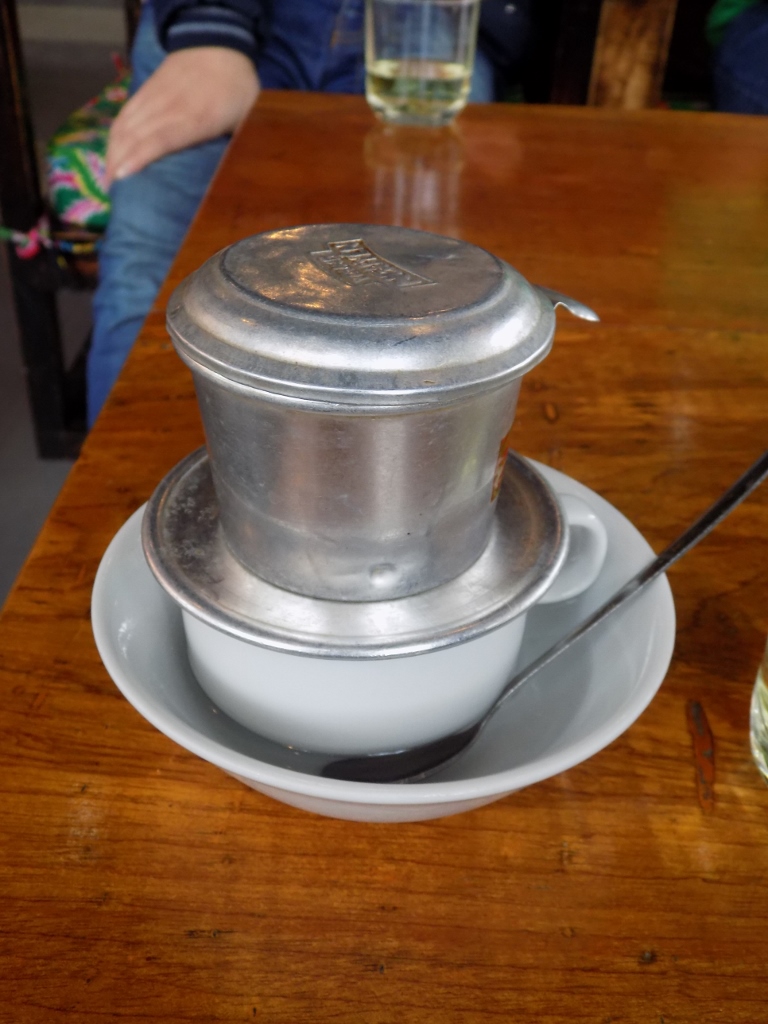 Waiting for the coffee to filter
Waiting for the coffee to filter
Talking about beverages, at this café we also got a glass of green tea as refreshment. I generally like teas in their different versions and I take tea regularly, but over time I’ve realized that for some completely unknown reason green tea in particular does not actually agree with me. So, I was a little sceptical as to how I would react, but I didn’t want to offend Luan and Long with whom we were sitting, so I drank it. As I’m not accustomed to its taste, I was not delighted, but eventually I had no problems and it all went well.
I also took this break as a fine opportunity to try to learn a few words of Vietnamese from Luan, the guide. Perhaps, this is a fine moment to say a few words on the subject. As far as I know, Vietnamese, like Chinese, is a tone language. These are not accents or the length of pronunciation of vowels, but rather different tones of the “same” sound, which are quite clearly audible to the people whose native tongues these are or who speak them well. The rest of us are completely lost. Practically, as if the tones were independent sounds in their own right and then two words which sound exactly the same to the people who do not speak the language actually have a completely different meaning. On this occasion, I learned how to say “thank you” and “hello” in Vietnamese and then until the end of my stay (more than three weeks) I kept repeating them, but the people usually appeared expressionless. Either I used this in wrong circumstances or I pronounced complete gibberish or I swore at them. Who knows?!
On the other hand, there is a frequent problem when the Vietnamese try to speak English. In the same way we appear “deaf” to their sounds, my impression was that they were “deaf” to the Indo-European sounds or at least to the English ones. Although we went to all of the tours with English-speaking guides, this actually varied quite a lot. We understood Luan quite well, but sometimes I found our guides completely incomprehensible. I would manage to understand every 15th word, which was insufficient for me to get the meaning, so I would most often give up on even listening to them. I also think that they actually “speak” the language quite well and that they can write it proficiently, but the major problem lies in the pronunciation. Not only do these tones create confusion, I think that the way in which the articulation system is used also contributes to the problem. Each language has its own specific way of using the anatomical sound “apparatus” – hence the frequent, strong and very typical accents when foreign languages are spoken.
In addition to this, Vietnamese is the only language in this part of the world which is written in the Latin script, of course with certain specificities. Namely, the Vietnamese language was traditionally written in a variant of the Chinese characters, but already in the 17th century, a French Jesuit missionary transcribed it into Latin characters on the basis of the previous works of some Portuguese missionaries. This was mostly used for Christian purposes, but in the 19th century, in order to rule with more ease, the French colonialists wanted to break as many connections with the tradition and spirituality as possible and thus by 1910 they managed to achieve that all the public documents were written in the Latin script. Since education on a more massive scale also started at the beginning of the 20th century, the use of a simpler script turned out to be a good thing and by the middle of the 20th century the work was done.
When we finished with our coffee and my torturing of the Vietnamese language, we moved on, for this was the day when we needed to cover the largest distance. Soon we entered the landscapes with rising terrain, as well as smallish tea plantations, for this area is well known for its green tea.
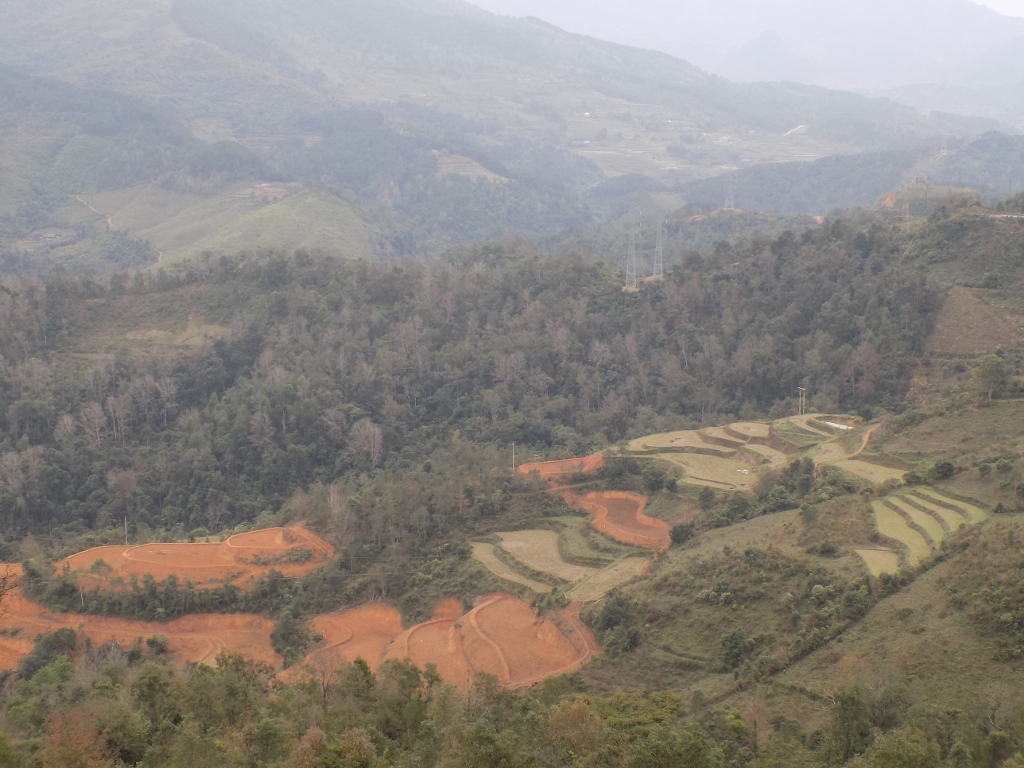 There are terraced fields in other parts of Vietnam, not only in Sa Pa
There are terraced fields in other parts of Vietnam, not only in Sa Pa
The road soon took us into a mountainous area. Although there are mountains here that could easily be seen anywhere else in the world, we often passed by isolated hills or mountains, I don’t even know what I would call them, that “rise” abruptly from the flat terrain. The flat ground was filled with paddies that were mostly brownish, since rice cultivation has only one season in the north of Vietnam and it was winter now so there was no rice in the fields.
We made a stop at a restaurant along our way and had lunch there. Luan asked us what we would like and we proposed chicken and pork, after which we all together went into the open kitchen and watched there the cooks preparing our dishes while we took photos of them. Afterwards we ate it all nicely.
And so we continued with our trip, passing the town of Cao Bang and heading in the direction of the border between Vietnam and China. According to the plan, we were to sleep in a village in which members of the Nung people live. When we started to turn from the main road, I could not believe my eyes. The entrance into the village appeared completely shabby, I saw a few structures that were spacious enough, but their walls were made of mud and with holes, so I wondered where in fact we would spend the night.
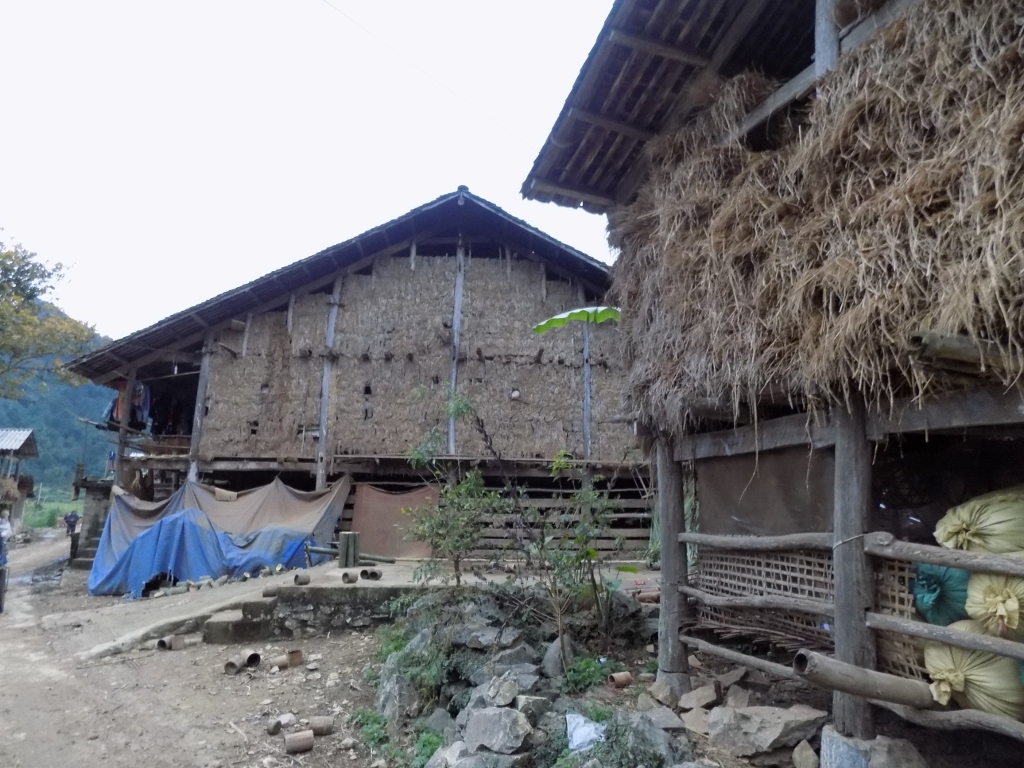 First sights from the village of Phia Thap
First sights from the village of Phia Thap
I have to admit that my first impression was significantly augmented on account of the experience from a couple of days earlier. Still, there was no way out and we were told to leave the mini-bus and walk to the house at which we would be placed. Although it was already quite cold, I found solace in the fact that at least it was not raining and my clothes were dry.
As the night was falling and we were walking along the narrow road that zigzagged over a low dyke elevated above the dry rice fields, we noticed a house in the distance which not only was lit quite well, but also stood out by its colour (dark red), and then Luan told us that this was where we were going.
There, our hosts (three generations of the same family live in the house, plus a girl who is a local English teacher) greeted us very warmly. Still, as opposed to the reception that was warm, the temperature in the house was quite low, even seemingly icy, and I kept sitting there dressed in two jackets and wrapped in a thin blanket. The point is that the people living in these areas are obviously quite used to this climate and the winter actually lasts for a very short period of time after which comes excessive heat, while the high humidity is a constant in all seasons, so they were clearly less sensitive to what seemed very cold to us (around 7 degrees Celsius). The house was very nice and made of good quality material, but it seemed to me it had no insulation, plus the door and the windows allowed ample passage of the outside air, so the temperature was almost the same inside as well as the outside. But then, our wonderful host noticed that the two of us were freezing and without saying a word he simply brought us a large dish full of embers and placed it by our feet so we started to get warm.
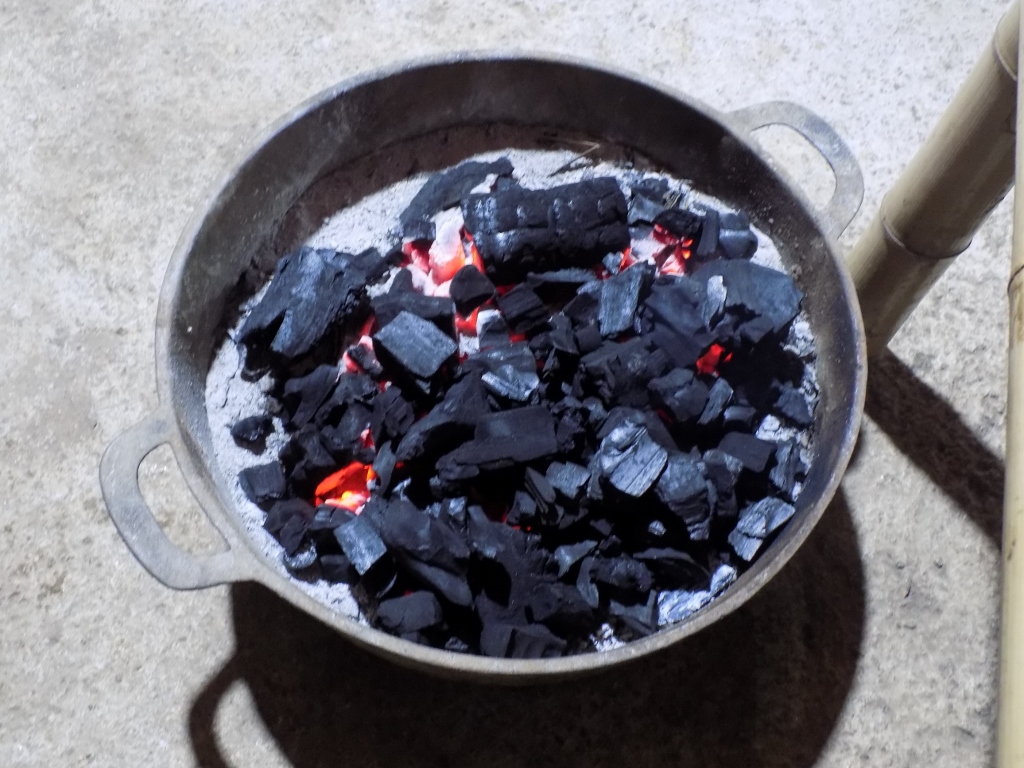 Movable “heater”
Movable “heater”
We also started to get used to our adventure and realized it was not bad at all. We even had an excellent Wi-Fi connection, so we could send a few photos to our friends and have a good laugh and fun. Then came dinner and it was sumptuous, but it was additionally great that we all sat together at the table and were merry. While drinking excellent, but strong rice brandy we practiced our modest Vietnamese by saying: “Thank you” and “Cheers!”
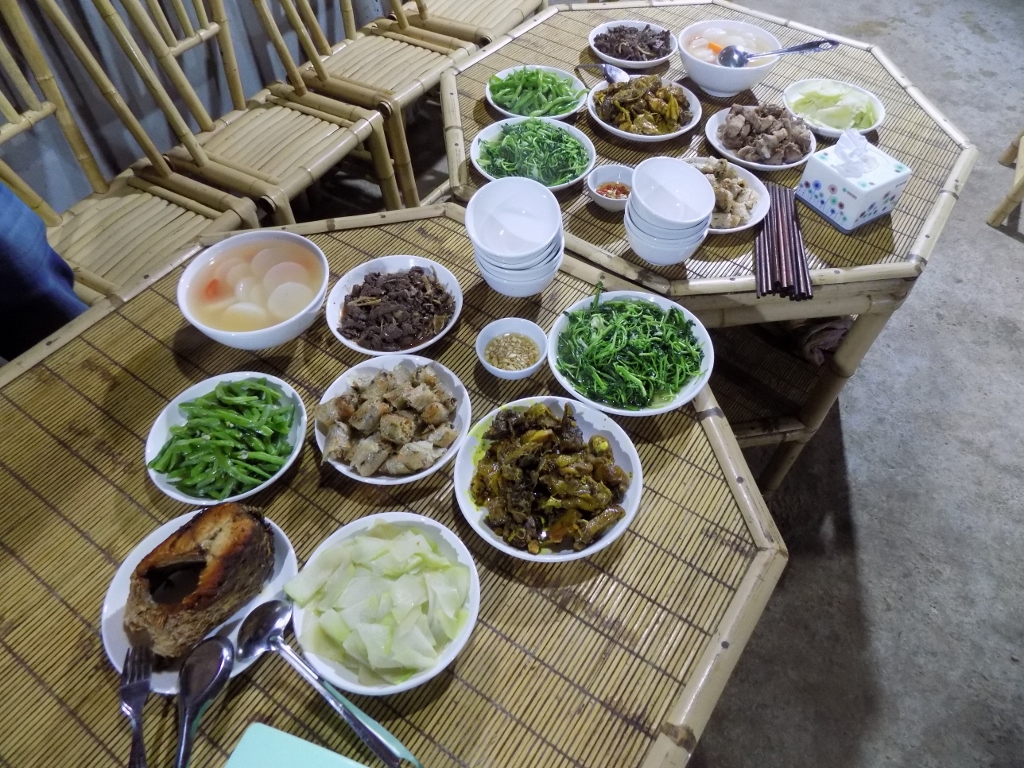 Dinner is on the table
Dinner is on the table
We went to bed early this evening as well. It was very cold, but each one of us got two thick duvets, so that this was good, although the very nice room made of some dark red wood was only covered by a roof, while it was completely open between the top of the walls and the roof construction. In other words, it was as if we slept outside, minus the wind. But, as I’ve said, the duvets were thick and warm, so I soon felt no cold at all. A partial problem though was the mat on which I was lying, which was placed directly on the floor so it was quite hard for me and I often woke up with the sensation that my own bones were bruising me from the inside.
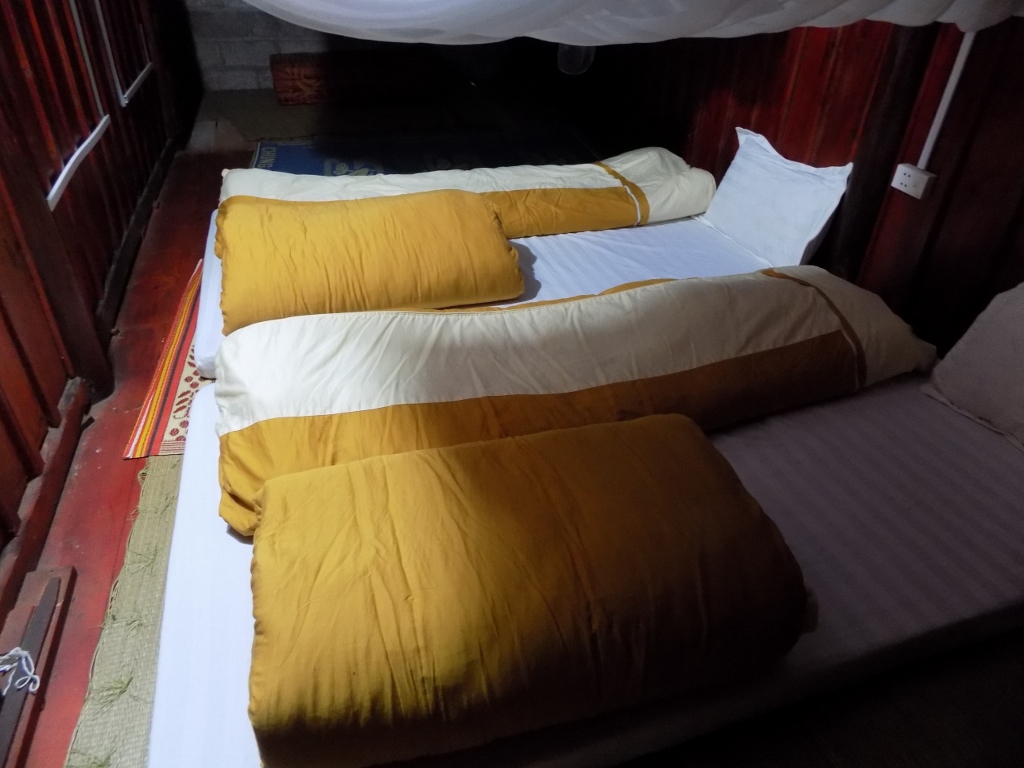 Our room in the village of Phia Thap
Our room in the village of Phia Thap
And so, when I got up at 6.30 the next morning I was a bit stiff, but still quite content. I dressed and went out (the hosts were already up), so I went for a walk, while Sneza joined me.
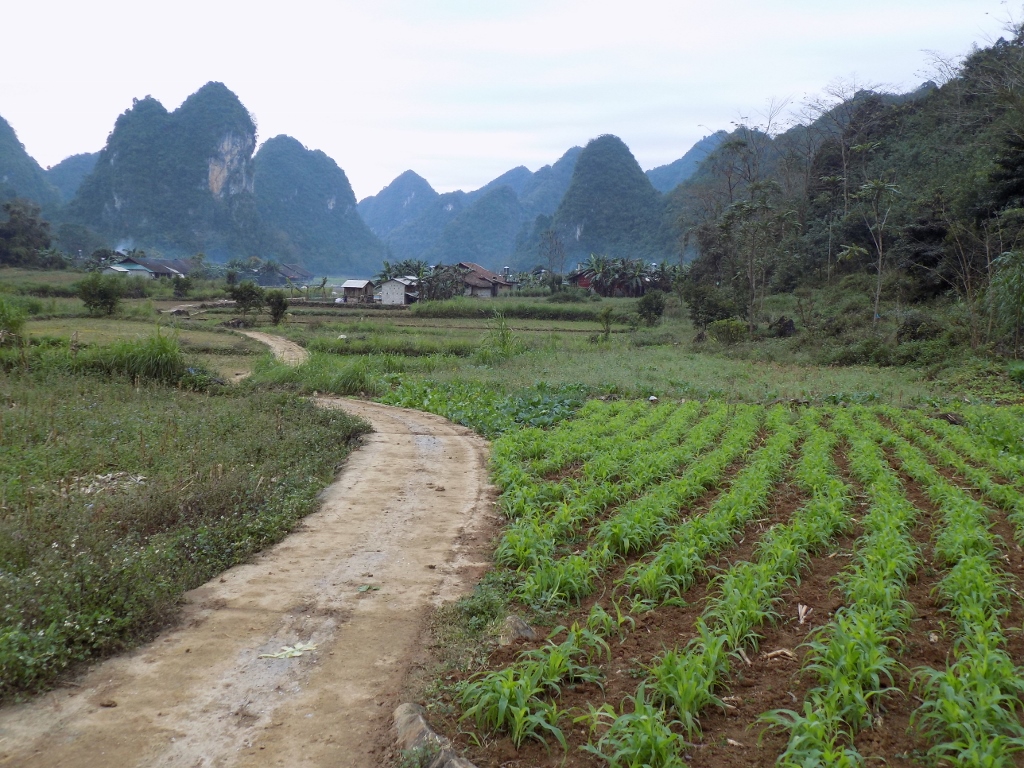 An early morning walk around the village of Phia Thap in the north-east of Vietnam
An early morning walk around the village of Phia Thap in the north-east of Vietnam
Soon we went back to the house and had breakfast there. At the same time, I admired the cutest little grandson of our hosts who was around 20 months old at the time we were there. With his round face, chubby cheeks and typical Vietnamese eyes, he was a proper little doll. Since he was getting ready to go out and have fun with his ride-on toy, they dressed him well and put a cap on his head. It turned out this was a traditional cap worn by the children in this part of the country. The patterns on it seemed as if drawn, but this was in fact a very fine and delicate embroidery.
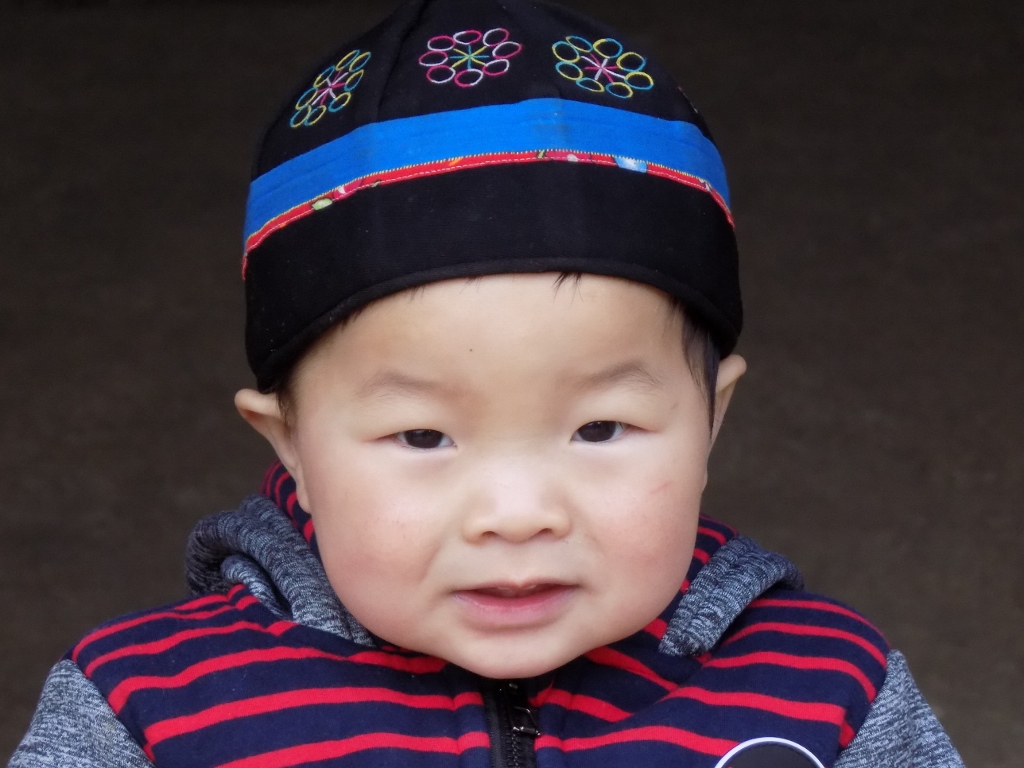 Aren’t I adorable?
Aren’t I adorable?
And then the time came for us to move on, but ... Before that, we bought some incense sticks for the production of which the village of Phia Thap is famous. Here they use leaves of a plant that are dried and finely ground and then the sticks that are twice as long as the standard ones are covered in this powder using a special process. While we were going towards the exit from the village, we stopped on numerous occasions to watch and take photos of the people doing this (mostly, but not solely women) and it was interesting that they all apologized for being “dirty.” I felt embarrassed that they apologized, for they were not dirty at all, they were just in the middle of their work. But, regardless of their concern about their appearance, they were all smiling.
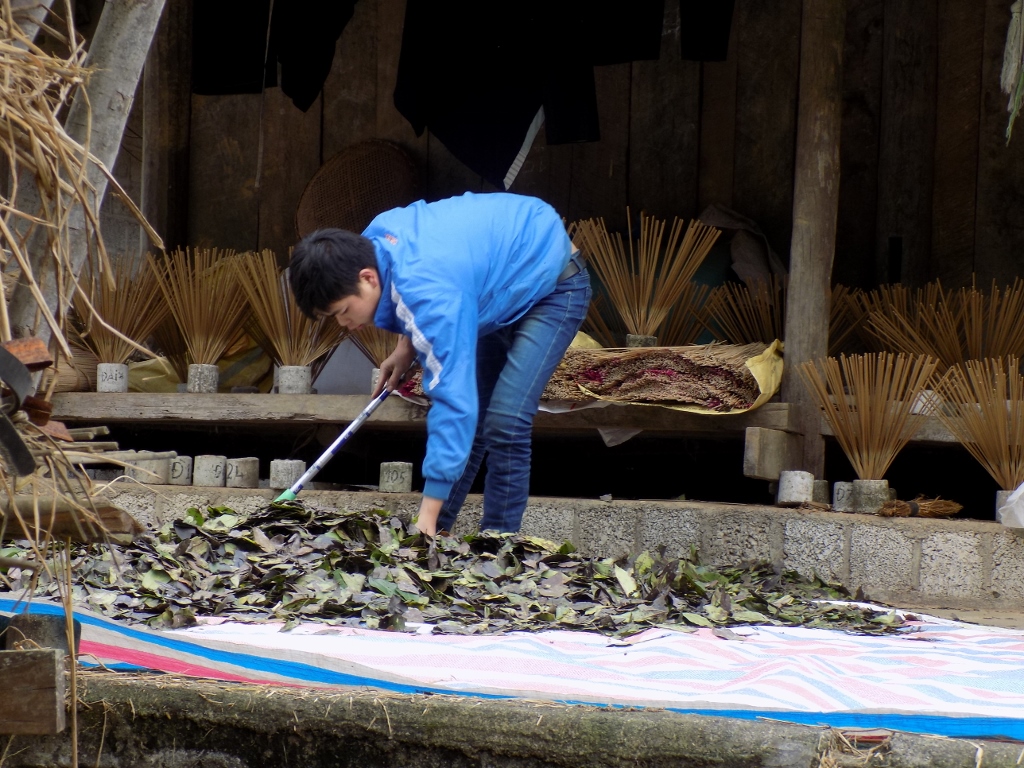 Preparation of the leaves used for the production of incense sticks
Preparation of the leaves used for the production of incense sticks
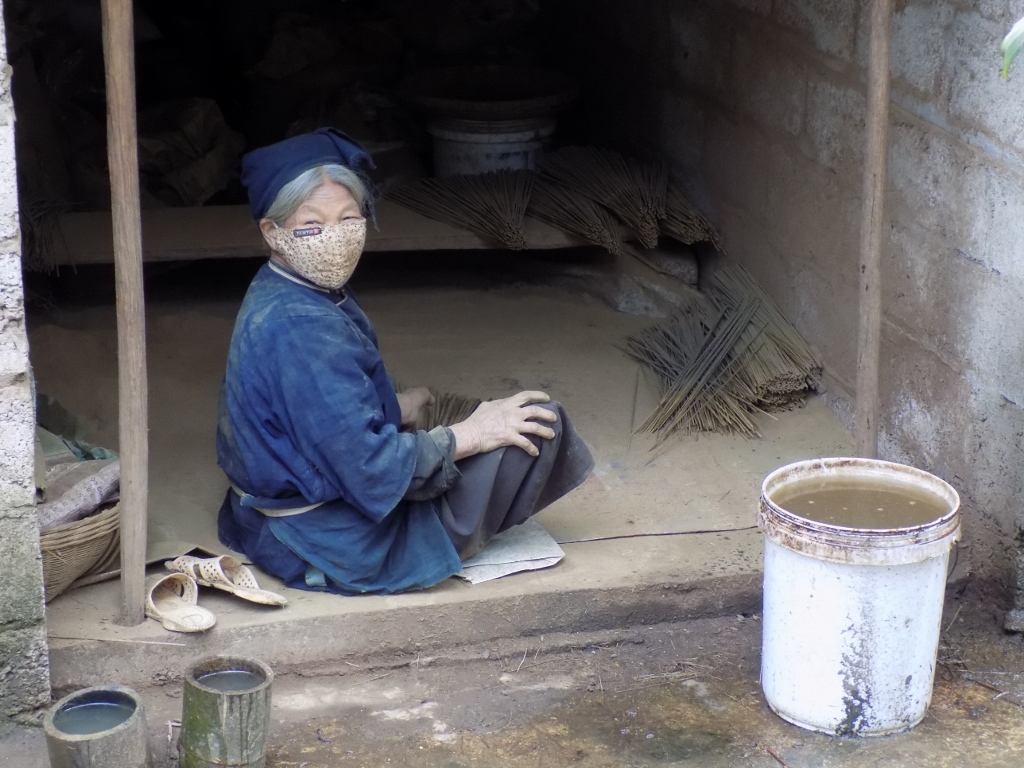 One of the women making the incense sticks by hand
One of the women making the incense sticks by hand
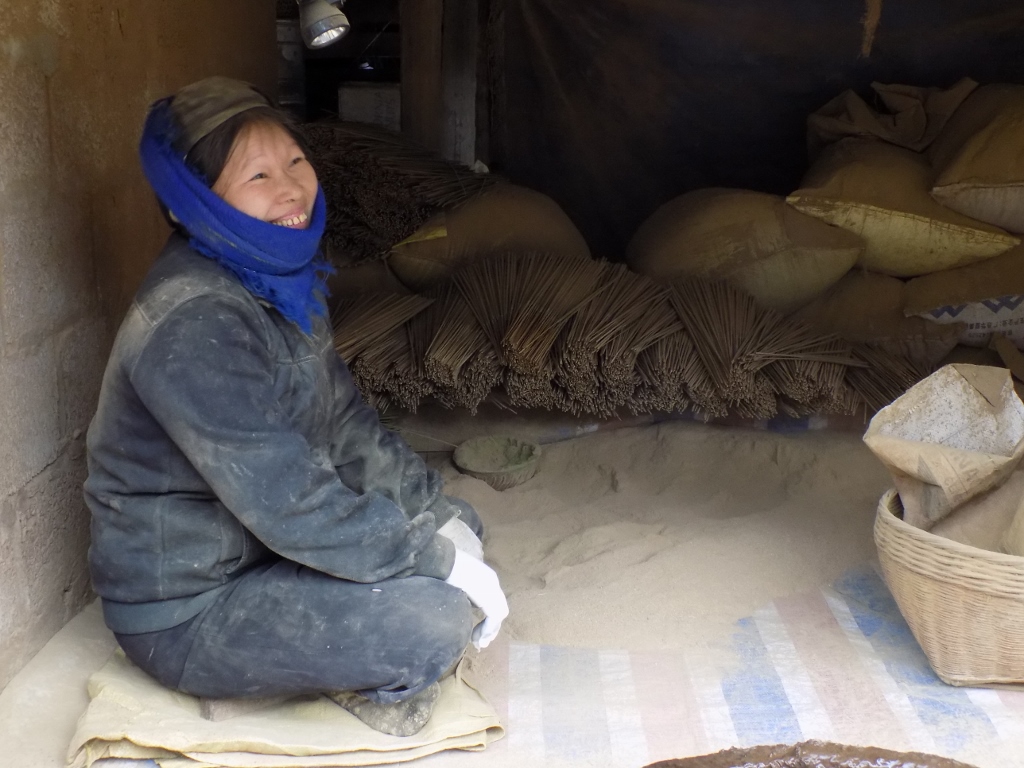 Another woman making the incense sticks
Another woman making the incense sticks
During the production, the incense sticks need to dry a couple of times and so throughout the village we could see bunches of incense sticks placed in some cylindrical bases.
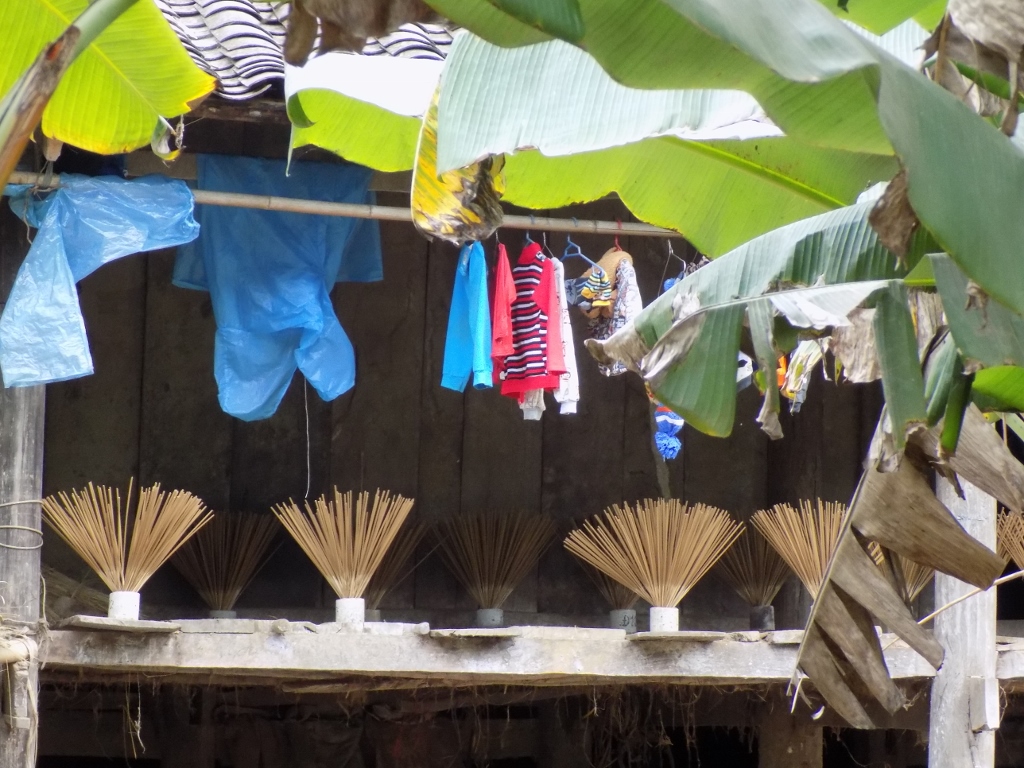 Both incense sticks and clothes are left out to dry
Both incense sticks and clothes are left out to dry
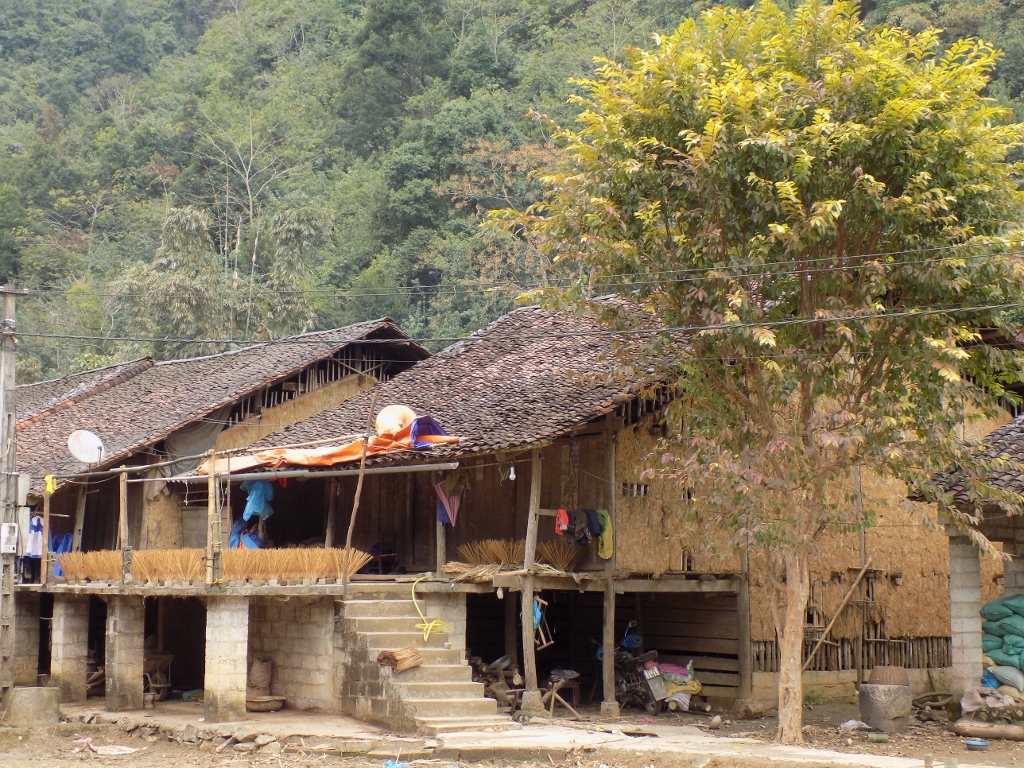 Incense sticks in the village of Phia Thap
Incense sticks in the village of Phia Thap
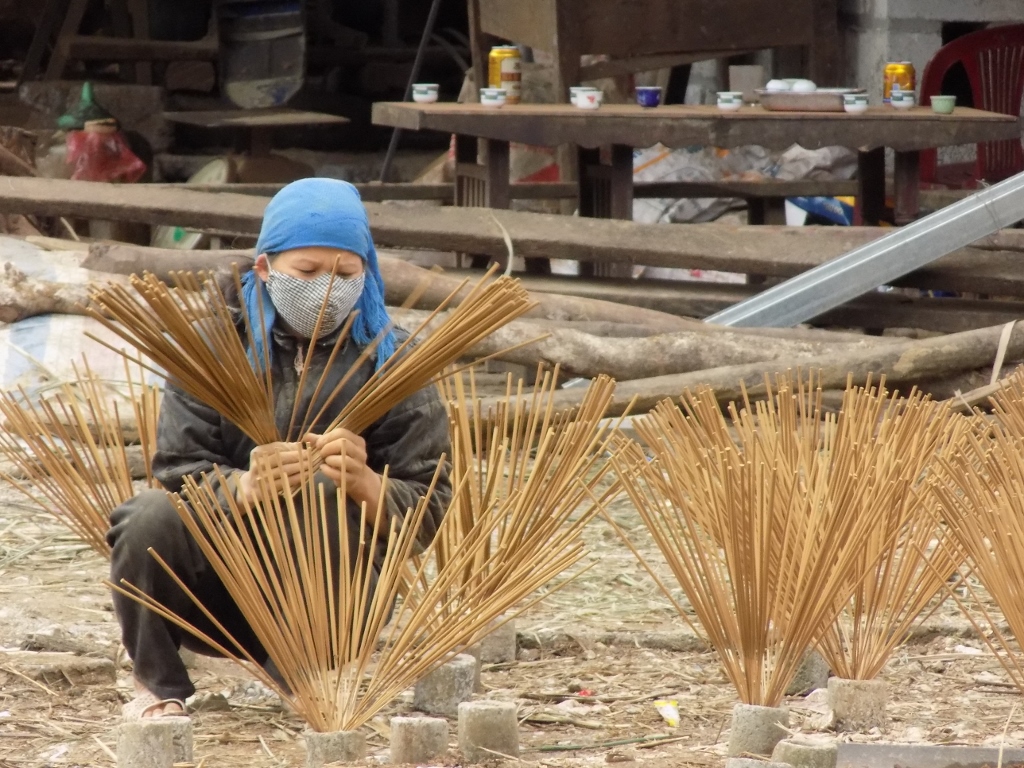 Putting incense sticks out to dry
Putting incense sticks out to dry
And also, in one place, we could see how the people take advantage of the winter season and empty rice fields by putting the sticks into the ground and leaving them there to dry.
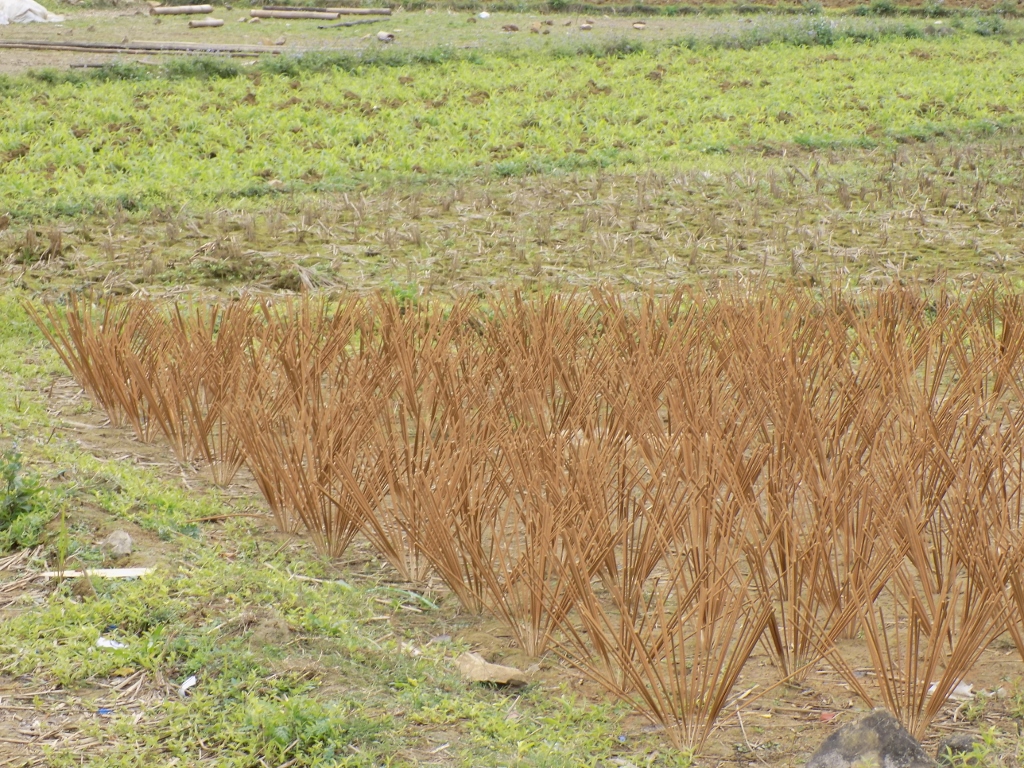 Drying of incense sticks in the village of Phia Thap
Drying of incense sticks in the village of Phia Thap
After looking at the production of incense sticks, we got into our mini-bus and headed towards the border with China.